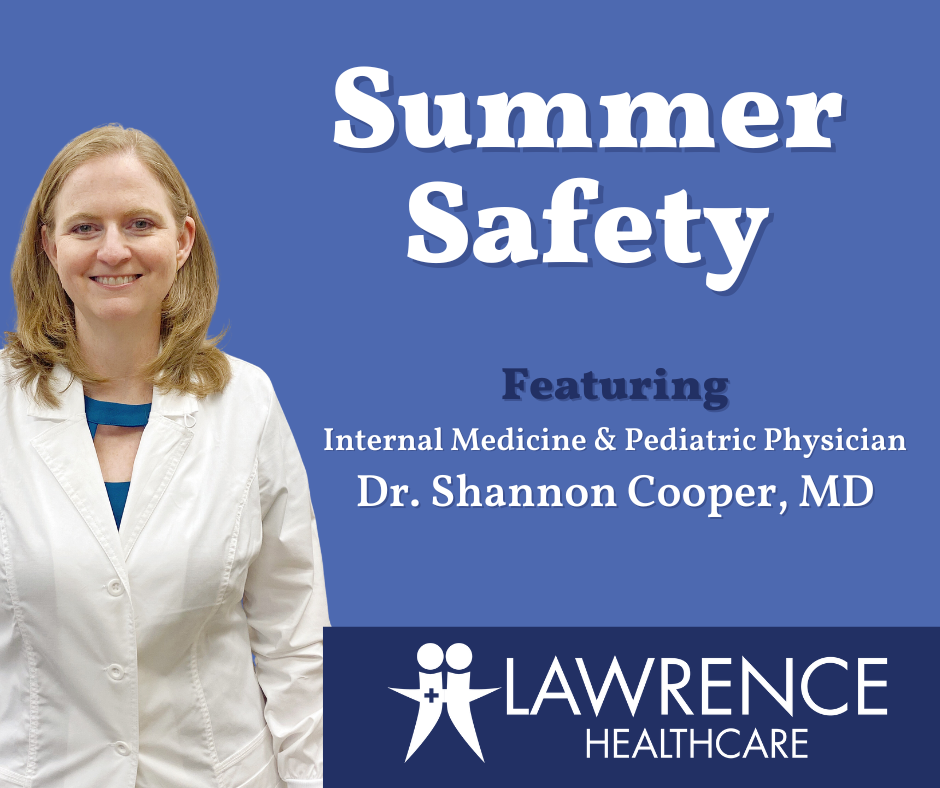Summer Safety

May is here and summer is coming! School is ending and warmer weather is here, so let's talk summer safety!
Sun Safety and Skin Cancer Awareness:
May is skin cancer awareness month. Skin cancer is the most common cancer in the United States and the world. One out of every five Americans will develop skin cancer by the age of 70. If you have had five or more sunburns in your lifetime, your risk of developing the most dangerous form of skin cancer, melanoma, is doubled. So how do we prevent skin cancer? It’s all about the sun protection!
Wear sunscreen every day and apply it often.
- Use sunscreen on sunny and cloudy days.
- Use a “broad-spectrum” sunscreen with both UVB and UVA ray protection.
- Use sun protection factor (SPF) of at least 15 and up to 50. An SPF of 30 provides excellent protection for most people. Sunscreens with higher than SPF 50 ratings have not been shown to provide any additional protection.
- If possible, use sunscreens that are made of zinc oxide or titanium dioxide (sometimes called mineral based), especially on sensitive body areas like the nose, cheeks, ears, and shoulders. Sunscreens containing oxybenzone have some mild hormonal properties and are more likely to cause skin sensitivity issues. However, if sunscreen containing oxybenzone is all you have, use it! Preventing sunburn is most important!
- Children less than 6 months should be kept out of direct sunlight as much as possible. Place babies under an umbrella, tree, or stroller canopy. If protective clothing and shade are not available, use mineral based sunscreen on small areas of the body, such as face, ears, and shoulders.
- When possible, wear cool, comfortable clothing that covers the body.
- Wear a large brim hat that protects the face, neck, and ears (at least a 3-inch brim is recommended).
- Wear sunglasses with at least 99% UV protection. These are important for adults and kids. UV rays damage the eyes over time and can lead to vision loss as we age.
- Limit sun exposure during the strongest times for UV rays, which occur between 10am and 4pm.

Water Safety:
Drowning is the second leading cause of death in children under 14 years of age, and most of these drownings occur in home/residential pools. Nearly 50% of these children were last seen inside the house and seen within 6 minutes of the drowning incident. Approximately 4000 Americans drown each year, including teenagers, and over 8000 non-fatal drownings occur each year in the United States.
Swimming safety recommendations:
- Learn to swim and teach your child to swim.
- Never swim alone or leave a child unsupervised.
- Learn CPR.
- Get out of the water during thunderstorms.
- Remove toys when the pool is not in use.
- If you have a small (“baby”) pool, empty it when not in use. Small children can drown in less than 1 inch of water.
- Wear a US Coast Guard approved life vest when around or near water. Children under age 13 are required to wear a life vest when on a moving boat.
Pool safety recommendations:
- Assign a designated pool watcher, especially at parties.

- Use a pool fence. This is the most effective way to prevent pool drownings in young children.
- Fence gate latch should be at least 54 inches high and should self-latch and self-close. The gate should be locked whenever the pool is not in use.
- Slats in fence should be 4 inches or less to prevent small children from sliding through the slats.
- Pool fences should be climb-proof. Avoid placing furniture near the fence, no footholds or handholds on the fence.
- Pool fences should be at least 4 feet tall and completely surround the pool with separation from the house and the rest of the yard.
- Use pool alarms, as well as alarms on pool fence gate and house doors.
Insect Bites and Stings Prevention:
Most insect bites and stings are benign and do not require medical attention. If stung by a wasp, bee, or other stinging insect, remove the stinger by gently scraping the skin. Then wash the skin with soap and water and apply ice for swelling and itching. Signs of a more severe reaction include large area of swelling, lip or tongue swelling, difficulty swallowing or speaking, chest tightness and shortness of breath, wheezing, dizziness, and vomiting. Seek emergency evaluation if these symptoms occur!
Prevention of insect bites and stings include avoiding going barefoot when walking in grass, avoid scented soaps and perfumes, avoid standing or playing near garbage cans, and use insect/bug spray!

Talk with your doctor about recommended insect sprays for children under 3 years of age.
To prevent a tick-borne illness, check yourself and your children for ticks when coming in from outdoor activities. Removal of a tick in less than 24 hours of attachment will prevent most infections. Wear pants when hiking or being in tall grass or the woods. Use insect spray on exposed skin.
If you find a tick, remove it using clean, fine-tipped tweezers. Grasp the tick as close to the skin surface as possible and remove with a steady pressure. After removing the tick, clean the area and your hands with soap and water or rubbing alcohol. If you develop fever or a rash within a few weeks of a tick bite, see your doctor for further evaluation.
References:
American Academy of Pediatrics and Healthychildren.org
Centers for Disease Control